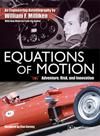|
Equations of Motion -
Adventure, Risk and Innovation
Price: $39.95
|

Cycle World, January 22, 2014
Character in Engineering: Who Wants To Spit Up Blood?
by Kevin Cameron
So often you hear older riders deploring the lack of "character" in today's motorcycles, yet it's clear that the modern product is better in every measurable way than the product of the 1960s and '70s. Is "character" to be dismissed as just oil leaks seen through rose-colored glasses? Or is there more to it?
This week, my reading has revealed a view that clarifies this question. I've been reading the excellent engineering autobiography of the late William Milliken, Equations of Motion (Bentley Publishers), and on page 276 is his view of this matter, which is well worth quoting.
"In the past, physical products of the human mind - houses, automobiles, aircraft, etc. - had progressed from pioneering to classical to the purely functional. In the early stages it is a matter of demonstrating feasibility. Once feasibility has been demonstrated, the classic period usually brings a proliferation of approaches by different designers. The purely functional configuration, based on the available scientific knowledge, becomes more stereotyped. Products of the classical stage are more individualistic, bearing the stamp of the designer who, unfettered by the demands of rigorous technology, can introduce humanizing elements of style and beauty."
This is just what we have seen with motorcycles, and it very neatly explains what "character" is in our context - and why some people seek and value it so much.
The earliest motorcycles, such as Daimler's wood-frame 1885 "Standuhr" and the many de Dion-engine bicycles and tricycles of the 1890s, were all proofs of feasibility, designs so primitive that all the work that went into them was consumed in just making them run. English motorcycle columnist "Ixion" described this period, saying that the "LPA" (Light Pedal Assistance) required from the rider in order to climb hills was actually lung-bursting effort that brought a taste of blood to one's mouth.
Once this stage was passed and the motorcycle was established as a practical product, the "proliferation of approaches" referred to by Milliken burst into flower. Suddenly there were singles, twins, and fours in great numbers, and all kinds of front and rear suspensions were tried. Shapes and styles multiplied. Multi-speed transmission by belt, chain, and gear eased the climbing of hills, and clutches set riders free of having to stop the engine at every cross street.
The Douglas opposed-twin had its cylinders fore-and-aft, while the ABC (All British [Engine] Company) experimented with projecting them to either side. Scott two-strokes presented rotary inlet valves and liquid cooling. Those who disliked being propelled by an irregular series of heavy thuds from singles could choose the smooth four-cylinder Belgian FN or American Henderson. Engines became parallel-twins, V-twins, flat-twins, triples, V-4s and inline-4s. High-performance English singles ruled the Isle of Man TT races, but big twins, such as the Brough and AJS, gave the long-distance rider something to pine for (Lawrence of Arabia owned many Broughs and wrote poetically of their qualities).
Vincent came into being, the first of the many attempts at rear suspension to persist in the market. Beginning in 1937 with Edward Turner's Triumph Speed Twin came the many British twins, with the postwar decade adding Norton, BSA, Royal Enfield, and AJS-Matchless to their number. Engineering students in 1923 began a development that would in time become the Gilera four-cylinder racer, the granddad of all of today's transverse inline-4s.
In the 1920s, there were nearly 200 makes of motorcycle being produced in England. In the US, the peak motorcycle year had been 1913, after which Henry's Model T took 99 percent of the transportation buyers. Then came the Great Depression, followed by its stepchild, World War II, which, between them, knocked out a large number of colorful motorcycle producers. These events erased much of the classic past.
Into the '60s market rushed rationally designed Japanese motorcycles, manufactured on the best automated tooling available. Features such as overhead cam, long considered too expensive for production machines, now became normal. Thus began Milliken's "purely functional configuration," a time when nearly pure reason - and production economics - took over design. Those among us most sensitive to such things began to complain that "Japanese machines...they're so functional, they do everything a motorcycle should do, but...they seem to have no soul."
Such complainers were crushed by the demonstrated superiority of The Japanese Way. The great names of the past (Triumph, BSA, Norton) faded, committed suicide, or dwindled away to glowing ember status (Moto Guzzi, Gilera, Benelli). Why? Once motorcycle production came to be defined by cost and design for manufacturing, there was no alternative to rationality.
Since then, classic brands have been occasionally "revived," a process made possible by combining modern automatic manufacturing with badge engineering. Certain makes (Harley-Davidson, Ducati, BMW) work hard at preserving specific elements of their character, but this adds cost. We see Harley and BMW keeping the air-cooled look alive by liquid-cooling their exhaust valve seats so they don't distort at freeway speeds. Ducati, MV, and Bimota capitalize on the motorcycle-as-art hand-built-racer look with wonderful eye candy.
And the mass market? It has been said, not without justification, that if their bikes were painted gray, only an expert could tell them apart.
And who was William Milliken? He was a founding father of automatic flight control for aircraft, who then moved into the vehicle dynamics of cars. If we trace back the origins of the electronic control systems now being widely adopted on motorcycles, we eventually come to William Milliken.

Review from and courtesy of Cycle World
http://www.cycleworld.com/2014/01/22/motorcycle-character-in-engineering-by-kevin-cameron
![[B] Bentley Publishers](http://assets1.bentleypublishers.com/images/bentley-logos/bp-banner-234x60-bookblue.jpg)
